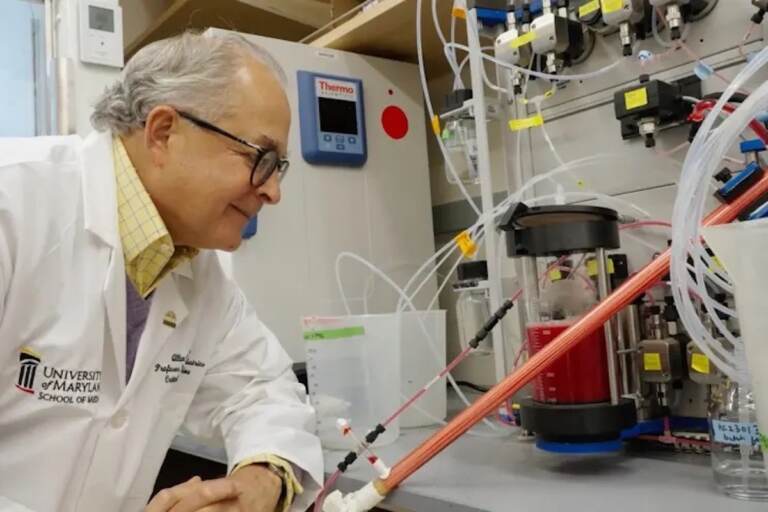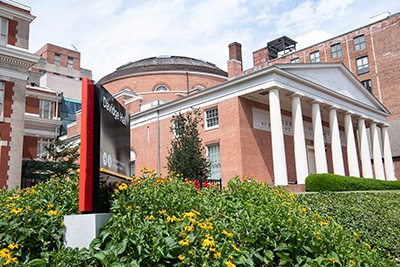Carnegie Foundation Places University of Maryland, Baltimore in Top Tier of U.S. Research Institutions
BALTIMORE, Maryland, February 13, 2025 — The University of Maryland, Baltimore (UMB) was designated today a Research 1 (R1) Institution by the American Council of Education (ACE) and the Carnegie Classification of Institutions of Higher Education (Carnegie Foundation). In the Carnegie Foundation’s news release, ACE President Ted Mitchell highlighted the new methodology used to classify U.S. research institutions, “which will shed light on institutions that have engaged in research but historically haven’t been recognized for it.” Mitchell added, “Instead of limiting research designations to the select institutions that award Ph.Ds, all types of colleges and universities will now be celebrated for their research contributions.”

Allan Doctor, MD
In a letter to the UMB community, President Bruce E. Jarrell, MD, FACS, and Provost and Executive Vice President Roger J. Ward, EdD, JD, MSL, MPA, celebrated the change of what they called an “arcane” rule.
“Although not an official ranking, R1 status influences legislative appropriations and other rankings. The University of Maryland, Baltimore (UMB) is a research powerhouse and has been for decades, but this marks the first time we’re designated ‘R1,’” they wrote.
To achieve R1 status, universities must spend at least $50 million on research and development in a year and award at least 70 research doctorates in a year. In 2024, UMB garnered more than $638 million in awards from both for-profit and nonprofit sponsors. Together with the University of Maryland, College Park, UMB is the ranked 11th nationally among public institutions in research and development by the National Science Foundation Herd Report with combined research expenditures of $1.4 billion.
In their letter, Jarrell and Ward expressed gratitude to the university’s research community. “More than two centuries ago, the Maryland General Assembly founded what is now UMB so ‘that many benefits would accrue, not only to the State of Maryland, but to many other parts of the United States.’ And every day since, starting as a medical school, and now as university with seven health, law, and human services professional schools, we have worked to improve lives by preparing the next generation of professionals who contribute to the discovery of the causes and treatments of disease and to finding solutions for addressing injustice through research.”
To achieve R1 status, universities must spend at least $50 million on research and development in a year and award at least 70 research doctorates each year. UMB reached and surpassed the $50 million milestone in 1987, when it grew from $36.9 to $57.9 million. As of 2024, UMB has garnered more than $638 million in awards from both for-profit and nonprofit sponsors across its seven schools. Upholding a strong collaboration with the global life sciences industry, the University conducts millions of dollars of corporate-sponsored research annually and engages in partnerships with more than 300 bioscience and pharmaceutical firms. Together with the University of Maryland, College Park, UMB is the ranked 11th nationally among public institutions in research and development by the National Science Foundation Herd Report with combined research expenditures of $1.4billion.
Despite the university’s long history of achievement, from being the first to predict the relationship between insects and disease in 1811, to completing the first successful pig heart-to-human xenotransplantation in 2022, UMB has not, until today, received full recognition for its place in America’s top tier of academic research institutions.
“The R1 designation recognizes UMB for what it has always been,” Jarrell and Ward wrote, “a top-tier research powerhouse worthy of its place among the nation’s top institutions. It’s about time UMB gets the recognition it deserves.”
About the University of Maryland, Baltimore
The University of Maryland, Baltimore (UMB) was founded in 1807 as the Maryland College of Medicine, which now stands as the nation’s oldest public medical school. In response to growing social and cultural needs, UMB’s mission has evolved and grown tremendously. Widely recognized as a preeminent institution, UMB serves as the academic health, law, and social work university of the University System of Maryland, and is guided by a mission of excellence in education, research, clinical care, and public service.
UMB is a thriving academic health center combining cutting-edge biomedical research, exceptional patient care, and nationally ranked academic programs. With extramural funding totaling $638 million in Fiscal Year 2024, each tenured/tenure-track faculty member generates an average of $1.5 million in research grants each year. More than 3,100 faculty members conduct leading-edge research and develop solutions and technologies that impact human health locally and around the world. World-class facilities and cores, as well as interprofessional centers and institutes, allow faculty to investigate pressing questions in a highly collaborative fashion. As a result, the more than 7,000 students, postdocs, and trainees directly benefit from working and learning alongside leading experts as they push the boundaries of their fields. For a listing of the organized research centers and institutes, visit: https://www.umaryland.edu/research/umb- research-profile/research-centers-and-institutions/
###
Media contact: Alex Likowski, alikowski@umaryland.edu


